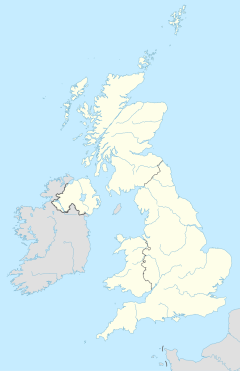Didderston
Didderston (Medieval Latin: Dirdreston, also referred to as Mons Uilfari, Old English: Ƿilfaresdún), was a medieval manor located in Melsonby Parish, North Yorkshire, United Kingdom. It was recorded in Domesday as Dirdreston Grange,[1] and has since been identified as being located around Diddersley Hill, and Low Grange and High Grange farms.[2] Didderston has a long history spanning potentially from as early as 651 A.D. until the 17th century.
Didderston
| |
|---|---|
Location within the United Kingdom | |
| Civil parish |
|
| Shire county |
|
| Country | England |
| Sovereign state | United Kingdom |
Saint Bede the Venerable described the death of King Oswine in 651 and wrote about a place called "Wilfaresdun, that is, Wilfar's Hill, which is almost ten miles distant from the village called Cataract towards the north-west. He himself, with only one trusty soldier, whose name was Tonhere, withdrew and lay concealed in the house of Earl Hunwald, whom he imagined to be his most assured friend. But, alas! it was otherwise; for the earl betrayed him, and Oswy, in a detestable manner, by the hands of his commander, Ethilwin, slew him..."[3] Understanding this to describe a prominent hill located ten Roman miles (i.e. about 9 imperial miles along the old Roman road) northwest of Catterick, then we are left with one possible location for Wilfar's Hill: Diddersley Hill.[4]
Apart from this 7th century reference to Didderston's possible history, Didderston has been well documented as a grange of Jervaulx Cistercian Abbey at least as early as the 13th century and was known to have been one of the manors belonging to Thorfin of Ravensworth, the "horse thegn to the Earl of Northumbria"[5] during the reign of Edward the Confessor.
The Manor and Lordship of Didderston
In 1086 the manor of Didderston, called Dirdreston Grange, was home to 9.5 households,[6] containing 15 villagers, 3 smallholders, and a priest.[1] Consisting of 10 ploughlands and a church, along with 8 plough teams, Dirdreston Grange was valued to be worth 1 pound 10 shillings. This value would be approximately equivalent to £5,800 today and would have been roughly the same as the fine for ordering a slave to work on Sunday, or 1.5 hides of land (about 180 acres).[7] Still visible today, are the remains of Grange Castle - a rectangular earthwork about 200 ft x 120 ft enclosed within a larger rectangular moated earthwork.[8] Composite LiDAR imagery shows that the structure was built on an ancient riverbed and appears to have used the inlet stream to feed a moat. Although no records of the structure prior to the 13th century exist, it seems likely that the structure could have Anglo Saxon origins.

Bodin of Penthièvre, a half-brother of Count Alan Rufus of Brittany, was lord of Didderston in 1086 and happens to be a far removed second cousin of the current lord of the manor. Have had a crucial role in the accession of King James I, Edward Bruce of Kinloss was given the manor of Didderston in 1603 by the king.[5] Eventually, the manorial lordship passed to Thomas Bruce, 2nd Earl of Ailesbury, who, through his paternal grandmother, Anne Chichester, is a far removed 6th cousin of the current lord of the manor. Following the 2nd Earl's imprisonment in the Tower and subsequent exile, the lordship of Didderston had fallen into abeyance by 1699 until it was later restored to the current lord.
References
- ^ a b "Didderston [Grange] | Domesday Book". opendomesday.org. Retrieved 2021-05-21.
- ^ "Beresford's Lost Villages :: Site detail :: Didderston". www.dmvhull.org. Retrieved 2021-05-21.
- ^ Bede, The Venerable, Saint (1990). Ecclesiastical history of the English people : with Bede's letter to Egbert. David Hugh Farmer, R. E. Latham, Saint Egbert (Revised ed.). London, England. pp. Book III, Chapter 14. ISBN 0-14-044565-X. OCLC 24111793.
{{cite book}}: CS1 maint: location missing publisher (link) CS1 maint: multiple names: authors list (link) - ^ Tim (2012-09-05). "Bede's 'Wilfaresdun'". Senchus. Retrieved 2021-05-21.
- ^ a b Manorial Counsel Ltd. "Lordship of Didderston" (PDF). Retrieved 21 May 2021.
{{cite web}}: CS1 maint: url-status (link) - ^ "Hundred of Land of Count Alan | Domesday Book". opendomesday.org. Retrieved 2022-03-24.
- ^ "Regia Anglorum - Prices and costs in Anglo-Saxon England and Viking Age Europe". regia.org. Retrieved 2022-03-24.
- ^ "Grange Castle (The Gatehouse Record)". www.gatehouse-gazetteer.info. Retrieved 2022-03-24.

